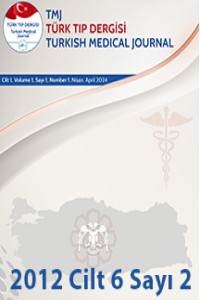Öz
Tinnitus is the perception of a ringing, buzzing or hissing sound without any source.1Acute tinnitus is treated like sudden deaffness, and resolves after finding and treating the underlying cause, however; there is only paliative treatment for chronic tinnitus. 9,10 Tinnitus has many causes. Subjective tinnitus is the false perception of sound without any enviromental source, it is heard only by the patient and is more common. Sound is real in the objective tinnitus and may be heard by putting a stethoscope near the head or neck of the patient.15,16
Anahtar Kelimeler
Kaynakça
- 1. Schlee W, Mueller N, Hartmann T, et al. Mapping cortical hubs in tinnitus. BMC Biol. 2009; 7: 80.
- 2. Moller, A.R. Tinnitus: presence and future. Prog. Brain Res. 2007; 166: 3–16.
- 3. Eggermont JJ, Roberts LE. The neuroscience of tinnitus. Trends Neurosci. 2004; 27: 676–682.
- 4. Fioretti A, Eibenstein A, Fusetti M. New Trends in Tinnitus Management. The Open Neurology Journal 2011; 5: 1217.
- 5. Baldo P, Doree C, Lazzarini R, Molin P, McFerran DJ. Antidepressants for patients with tinnitus. Cochrane Database of Systematic Reviews.2006;18: CD003853.
- 6. Schleuning AJ. Management of the patient with tinnitus. Med Clin North Am. 1991; 75: 1225-37.
- 7. Salvago P et al. Tinnitus Patients: Etiologic, Audiologic And Psychological Profile.Acta Medica Mediterranea. 2012; 28: 171.
- 8. Lenarz T. Diagnosis and therapy of tinnitus. Laryngo-Rhino-Otologie. 1998; 77 : 54-60.
- 9. Folmer RL, Martin WH, Shi Y. Tinnitus:Questions to reveal the cause,answers to provide relief. The Journal of Family Practice. 2004; 53: 7.
- 10. Heller AJ: Classification and epidemiology of tinnitus. Otolaryngol Clin North Am. 2003; 36: 239–248.
- 11. Schutte NS, Noble W, Malouff JM, et al. Evaluation of a model of distress related to tinnitus. Int J Audiol 2009; 48: 428–432.
- 12. Gopinath B, McMahon CM, Rochtchi-na E, et al.: Risk factors and impacts of incident tinnitus in older adults. Ann Epidemiol. 2010; 20: 129–135.
- 13. Stouffer JL, Tyler RS, Kileny PR, Dalzell LE. Tinnitus as a function of duration and etiology: counselling implications. Am J Otol. 1991; 12: 188-194.
- 14. Lockwood AH, Salvi RJ, Burkard RF. Tinnitus. N Engl J Med. 2002; 347: 904–910.
- 15. Weissman JL. Hearing loss. Radiology. 1996; 199: 593–611.
- 16. Gulya AJ. Evaluation of tinnitus. In: Goroll AH, Mulley AG, eds. Primary care medicine: office evaluation and management of the adult patient. 4th ed. Philadelphia: Lippincott Williams & Wilkins; 2000: 1123-5.
- 17. Meikle M, Taylor-Walsh E. Characteristics of tinnitus and related observations in over 1800 tinnitus clinic patients. J Laryngol Otol Suppl. 1984; 9: 17-21.
- 18. Heller AJ. Classification and epidemiology of tinnitus. Otolaryngol Clin North Am. 2003; 36 : 239-48.
- 19. Axelsson A, Ringdahl A. Tinnitus, a study of its prevalence and characteristics. Br J Audiol. 1989; 23: 53-62.
- 20. Weber PC, Klein AJ. Hearing loss. Med Clin North Am. 1999; 83: 125-37.
- 21. Dobie RA. Suffering from tinnitus. In: Snow JB(ed), Tinnitus: Theory and Management.1st ed. Toronto:Decker; 2004:1-2.
- 22. Haln TC, Micco A. Vestibulocochlear system. In: Goetz CG, Pappert EJ,. Textbook of clinical neurology. 1st ed. Philadelphia: Saunders; 1999: 184-99.
- 23. Spoelhof GD. When to suspect an acoustic neuroma. Am Fam Physician. 1995; 52: 1768-74.
- 24. Yorgason, J. G., Fayad, J. N., & Kali-nec, F. Understanding drug ototoxicity: Molecular insights for prevention and clinical management. Expert Opinion on Drug Safety. 2006; 5: 383-399.
- 25. Crummer R, & Hassan G. Diagnostic approach to tinnitus. American Family Physician. 2004; 69: 120-128.
- 26. Black FO, Pesznecker SC. Vestibular ototoxicity. Clinical considerations. Otolaryngol Clin North Am. 1993; 26: 713-36.
- 27. Kazmierczak H, Doroszewska G. Metabolic disorders in vertigo, tinnitus and hearing loss. International Tinnitus Journal. 2001; 7: 54-58.
- 28. Kraft JR. Hyperinsulinemia: A merging history with idiopathic tinnitus, vertigo and hearing loss. International Tinnitus Journal. 1998; 4: 127-130.
- 29. Akyıldız N. Tinnitus, Kulak hastalıkları ve Mikrocerrahisi. Cilt II, Ankara: Bilimsel Tıp Yayınevi; 2002: 67-81.
- 30. Celik O. Tinnitus. Ozluoğlu L, Ataş A. Kulak burun boğaz hastalıkları ve baş boyun cerrahisi.1. Baskı. İstanbul: Turgut Yayıncılık; 2002; 1 : 88-98
- 31. Folmer, R. L., & Griest, S. E. Chronic tinnitus resulting from head or neck injuries. Laryngoscope. 2003; 113: 821827.
- 32. Folmer, R. L., & Griest, S. E. Tinnitus and insomnia. American Journal of Otolaryngology. 2000; 21: 287-293.
- 33. Moller AR.Tinnitus:presence and fu-ture.Prog Brain Res 2007; 166: 3-16.
- 34. Lockwood AH, Salvi RJ, Burkard RF. Tinnitus. N Engl J Med 2002; 347: 904910.
- 35. Penner MJ. Linking spontaneous otoa-coustic emissions and tinnitus. Br J Au-diol 1992; 26: 115-123.
- 36. Lockwood AH, Salvi RJ, Burkard RF. Tinnitus. N Engl J Med 2002; 347: 905906.
- 37. Lockwood AH, Salvi RJ, Coad ML, Towsley ML, Wack DS, Murphy BW. The functional neuroanatomy of tinnitus: evidence for limbic system links and neural plasticity. Neurology 1998; 50: 114-20.
- 38. Pinchoff RJ, Burkard RF, Salvi RJ, Coad ML, Lockwood AH. Modulation of tinnitus by voluntary jaw movements. Am J Otol 1998; 19: 785-9.
- 39. Levine RA. Somatic modulation appears to be a fundamental attribute of tinnitus. In: Hazell JPW, ed. Proceedings of the Sixth International Tinnitus Seminar. London: Tinnitus and Hyper-acusis Center; 2001: 193-7.
- 40. Crummer RW, Hassan GA, Diagnostic Approach to Tinnitus. American Family Physician 2004; 69 : 120-6.
- 41. Schleuning AJ 2d. Management of the patient with tinnitus. Med Clin North Am. 1991; 75: 1225-37.
- 42. Henry JA, Zaugg TL, Myers PM et al. Progressive Tinnitus Management. Clinical Handbook for Audiologists Appendixes. Long Beach, CA: VA Employee Education System; 2010; 59: 97.
Öz
Tinnitus uyarı yokluğunda, çınlayan ,uğuldayan veya tıslayan tekrarlayıcı sesin algılanmasıdır.1 Akut tinnitus, ani gelişen işitme kaybı gibi ele alınır ve altta yatan sebep genellikle bulunup tedavi edilerek tinnitusun geçmesi sağlanır.Ancak kronik tinnitus için sadece palyatif tedavi söz konusudur. Tinnitus birçok olası sebebe sahiptir. Subjektif tinnitus, çevrede herhangi bir ses kaynağı olmaksızın, hatalı olarak ses algılanmasıdır, sadece hasta tarafından duyulur, daha sıktır. Objektif tinnitusta ise duyulan ses olasılıkla gerçektir ve hasta kulak yakınındaki baş ve boyun yapılarına stetoskop konarak da duyulabilir.
Kaynakça
- 1. Schlee W, Mueller N, Hartmann T, et al. Mapping cortical hubs in tinnitus. BMC Biol. 2009; 7: 80.
- 2. Moller, A.R. Tinnitus: presence and future. Prog. Brain Res. 2007; 166: 3–16.
- 3. Eggermont JJ, Roberts LE. The neuroscience of tinnitus. Trends Neurosci. 2004; 27: 676–682.
- 4. Fioretti A, Eibenstein A, Fusetti M. New Trends in Tinnitus Management. The Open Neurology Journal 2011; 5: 1217.
- 5. Baldo P, Doree C, Lazzarini R, Molin P, McFerran DJ. Antidepressants for patients with tinnitus. Cochrane Database of Systematic Reviews.2006;18: CD003853.
- 6. Schleuning AJ. Management of the patient with tinnitus. Med Clin North Am. 1991; 75: 1225-37.
- 7. Salvago P et al. Tinnitus Patients: Etiologic, Audiologic And Psychological Profile.Acta Medica Mediterranea. 2012; 28: 171.
- 8. Lenarz T. Diagnosis and therapy of tinnitus. Laryngo-Rhino-Otologie. 1998; 77 : 54-60.
- 9. Folmer RL, Martin WH, Shi Y. Tinnitus:Questions to reveal the cause,answers to provide relief. The Journal of Family Practice. 2004; 53: 7.
- 10. Heller AJ: Classification and epidemiology of tinnitus. Otolaryngol Clin North Am. 2003; 36: 239–248.
- 11. Schutte NS, Noble W, Malouff JM, et al. Evaluation of a model of distress related to tinnitus. Int J Audiol 2009; 48: 428–432.
- 12. Gopinath B, McMahon CM, Rochtchi-na E, et al.: Risk factors and impacts of incident tinnitus in older adults. Ann Epidemiol. 2010; 20: 129–135.
- 13. Stouffer JL, Tyler RS, Kileny PR, Dalzell LE. Tinnitus as a function of duration and etiology: counselling implications. Am J Otol. 1991; 12: 188-194.
- 14. Lockwood AH, Salvi RJ, Burkard RF. Tinnitus. N Engl J Med. 2002; 347: 904–910.
- 15. Weissman JL. Hearing loss. Radiology. 1996; 199: 593–611.
- 16. Gulya AJ. Evaluation of tinnitus. In: Goroll AH, Mulley AG, eds. Primary care medicine: office evaluation and management of the adult patient. 4th ed. Philadelphia: Lippincott Williams & Wilkins; 2000: 1123-5.
- 17. Meikle M, Taylor-Walsh E. Characteristics of tinnitus and related observations in over 1800 tinnitus clinic patients. J Laryngol Otol Suppl. 1984; 9: 17-21.
- 18. Heller AJ. Classification and epidemiology of tinnitus. Otolaryngol Clin North Am. 2003; 36 : 239-48.
- 19. Axelsson A, Ringdahl A. Tinnitus, a study of its prevalence and characteristics. Br J Audiol. 1989; 23: 53-62.
- 20. Weber PC, Klein AJ. Hearing loss. Med Clin North Am. 1999; 83: 125-37.
- 21. Dobie RA. Suffering from tinnitus. In: Snow JB(ed), Tinnitus: Theory and Management.1st ed. Toronto:Decker; 2004:1-2.
- 22. Haln TC, Micco A. Vestibulocochlear system. In: Goetz CG, Pappert EJ,. Textbook of clinical neurology. 1st ed. Philadelphia: Saunders; 1999: 184-99.
- 23. Spoelhof GD. When to suspect an acoustic neuroma. Am Fam Physician. 1995; 52: 1768-74.
- 24. Yorgason, J. G., Fayad, J. N., & Kali-nec, F. Understanding drug ototoxicity: Molecular insights for prevention and clinical management. Expert Opinion on Drug Safety. 2006; 5: 383-399.
- 25. Crummer R, & Hassan G. Diagnostic approach to tinnitus. American Family Physician. 2004; 69: 120-128.
- 26. Black FO, Pesznecker SC. Vestibular ototoxicity. Clinical considerations. Otolaryngol Clin North Am. 1993; 26: 713-36.
- 27. Kazmierczak H, Doroszewska G. Metabolic disorders in vertigo, tinnitus and hearing loss. International Tinnitus Journal. 2001; 7: 54-58.
- 28. Kraft JR. Hyperinsulinemia: A merging history with idiopathic tinnitus, vertigo and hearing loss. International Tinnitus Journal. 1998; 4: 127-130.
- 29. Akyıldız N. Tinnitus, Kulak hastalıkları ve Mikrocerrahisi. Cilt II, Ankara: Bilimsel Tıp Yayınevi; 2002: 67-81.
- 30. Celik O. Tinnitus. Ozluoğlu L, Ataş A. Kulak burun boğaz hastalıkları ve baş boyun cerrahisi.1. Baskı. İstanbul: Turgut Yayıncılık; 2002; 1 : 88-98
- 31. Folmer, R. L., & Griest, S. E. Chronic tinnitus resulting from head or neck injuries. Laryngoscope. 2003; 113: 821827.
- 32. Folmer, R. L., & Griest, S. E. Tinnitus and insomnia. American Journal of Otolaryngology. 2000; 21: 287-293.
- 33. Moller AR.Tinnitus:presence and fu-ture.Prog Brain Res 2007; 166: 3-16.
- 34. Lockwood AH, Salvi RJ, Burkard RF. Tinnitus. N Engl J Med 2002; 347: 904910.
- 35. Penner MJ. Linking spontaneous otoa-coustic emissions and tinnitus. Br J Au-diol 1992; 26: 115-123.
- 36. Lockwood AH, Salvi RJ, Burkard RF. Tinnitus. N Engl J Med 2002; 347: 905906.
- 37. Lockwood AH, Salvi RJ, Coad ML, Towsley ML, Wack DS, Murphy BW. The functional neuroanatomy of tinnitus: evidence for limbic system links and neural plasticity. Neurology 1998; 50: 114-20.
- 38. Pinchoff RJ, Burkard RF, Salvi RJ, Coad ML, Lockwood AH. Modulation of tinnitus by voluntary jaw movements. Am J Otol 1998; 19: 785-9.
- 39. Levine RA. Somatic modulation appears to be a fundamental attribute of tinnitus. In: Hazell JPW, ed. Proceedings of the Sixth International Tinnitus Seminar. London: Tinnitus and Hyper-acusis Center; 2001: 193-7.
- 40. Crummer RW, Hassan GA, Diagnostic Approach to Tinnitus. American Family Physician 2004; 69 : 120-6.
- 41. Schleuning AJ 2d. Management of the patient with tinnitus. Med Clin North Am. 1991; 75: 1225-37.
- 42. Henry JA, Zaugg TL, Myers PM et al. Progressive Tinnitus Management. Clinical Handbook for Audiologists Appendixes. Long Beach, CA: VA Employee Education System; 2010; 59: 97.
Ayrıntılar
| Birincil Dil | Türkçe |
|---|---|
| Konular | Klinik Tıp Bilimleri (Diğer) |
| Bölüm | Derlemeler |
| Yazarlar | |
| Yayımlanma Tarihi | 21 Ağustos 2012 |
| Yayımlandığı Sayı | Yıl 2012 Cilt: 6 Sayı: 2 |



